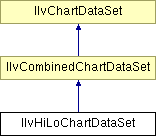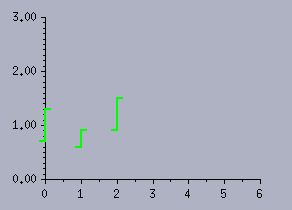
Rogue Wave Views 5.6
Rogue Wave Views
Charts Package API Reference Guide
Rogue Wave Views
Documentation Home
 Rogue Wave Views 5.6 |
Rogue Wave Views |
Rogue Wave Views Documentation Home |
Class defining a combined data set used by high-low displayers. More...
#include <ilviews/charts/data.h>

Public Member Functions | |
| virtual IlUInt | getIndexInCombined (const IlvChartDataSet *dataSet, IlUInt indexInDataSet) const |
| Maps a point index in a component data set to an index in the combined data set. | |
| virtual IlUInt | getIndexInDataSet (IlvChartDataSet *&dataSet, IlUInt indexInCombined) const |
| Maps a point index in the current combined data set to an index in a component data set. | |
| virtual void | getPoint (IlUInt i, IlvDoublePoint &point) const |
| Returns a represented data point. | |
| virtual IlBoolean | retrieveDataSetPoint (IlvChartDataSet *&dataSet, IlUInt ptidx, const IlvDoublePoint &point, IlUInt &dataSetPtIndex, IlvDoublePoint &dataSetPt) const |
| Retrieves from a data point of the current combined data set the corresponding data point of a component data set. | |
| virtual void | setDataCount (IlUInt count) |
| Sets the number of considered data points from the number of data items considered in the component data sets. | |
Class defining a combined data set used by high-low displayers.
Library: ilvcharts
This class is a subclass of IlvCombinedChartDataSet which is used by a high-low displayer to put the data to be displayed into a format that the displayer can display. A high-low-data-set is composed of the alternate data items of the two data sets that are set on the high-low displayer. It consists of the first data item of the first data set followed by the first data item of the second data set, then the second data item of the first data set followed by the second data item of the second data set, and so on.
The following example illustrates a high-low-data-set. The real data sets that are set on a high-low displayer are shown in the left column and the high-low-data-set that is constructed from these data sets is shown in the right column. See the IlvHiLoChartDisplayer class to have more information.
| 
|
IlvCombinedChartDataSet, IlvHiLoChartDisplayer. | virtual IlUInt IlvHiLoChartDataSet::getIndexInCombined | ( | const IlvChartDataSet * | dataSet, | |
| IlUInt | indexInDataSet | |||
| ) | const [virtual] |
Maps a point index in a component data set to an index in the combined data set.
Maps the point index indexInDataSet in the data set dataSet to an index in the current combined data set.
| dataSet | The data set considered in the combined data set. | |
| indexInDataSet | The index of the data point in the data set dataSet. |
Reimplemented from IlvCombinedChartDataSet.
| virtual IlUInt IlvHiLoChartDataSet::getIndexInDataSet | ( | IlvChartDataSet *& | dataSet, | |
| IlUInt | indexInCombined | |||
| ) | const [virtual] |
Maps a point index in the current combined data set to an index in a component data set.
Maps the point index indexInCombined in the current combined data set to an index in the corresponding data set among the data sets that make up the current combined data set.
| dataSet | This parameter is set to the corresponding data set in the combined data set. | |
| indexInCombined | The index of the point in the combined data set. |
Reimplemented from IlvCombinedChartDataSet.
| virtual void IlvHiLoChartDataSet::getPoint | ( | IlUInt | i, | |
| IlvDoublePoint & | point | |||
| ) | const [virtual] |
Returns a represented data point.
| i | The index of the returned data point. | |
| point | The returned data point. |
Implements IlvChartDataSet.
| virtual IlBoolean IlvHiLoChartDataSet::retrieveDataSetPoint | ( | IlvChartDataSet *& | dataSet, | |
| IlUInt | ptidx, | |||
| const IlvDoublePoint & | point, | |||
| IlUInt & | dataSetPointIndex, | |||
| IlvDoublePoint & | dataSetPoint | |||
| ) | const [virtual] |
Retrieves from a data point of the current combined data set the corresponding data point of a component data set.
0), dataSet is set to a default data set which is one of the data sets that make up the current combined data set.| dataSet | The component data set for which we want to retrieve a data point. This data set is one of the data sets that make up the current combined data set. | |
| ptidx | The index of the data point of the current combined data set from which we want to retrieve the corresponding point in dataSet. | |
| point | The point of the current combined data set from which we want to retrieve the corresponding point in dataSet. | |
| dataSetPointIndex | The index of the retrieved point in the data set dataSet. | |
| dataSetPoint | The retrieved point in the data set dataSet. |
IlTrue if the data point has been successfully retrieved and IlFalse otherwise. Implements IlvCombinedChartDataSet.
| virtual void IlvHiLoChartDataSet::setDataCount | ( | IlUInt | count | ) | [virtual] |
Sets the number of considered data points from the number of data items considered in the component data sets.
Sets the number of data points considered for the current combined data set. This number is set to the number of data points that can be computed from the component data sets when count data items are considered in each component data set.
| count | The number of data items considered in the data sets that make up the combined data set. |
Reimplemented from IlvCombinedChartDataSet.
© Copyright 2012, Rogue Wave Software, Inc. All Rights Reserved.
Rogue Wave is a registered trademark of Rogue Wave Software, Inc. in the United States and other countries. All other trademarks are the property of their respective owners.